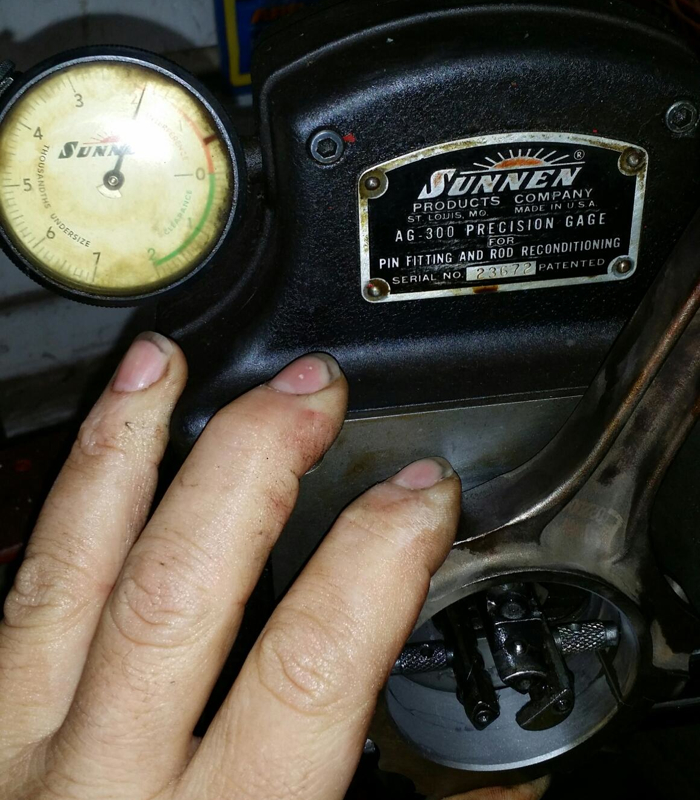 Resize Cracked Rods? Yes, You Certainly Can!
Resize Cracked Rods? Yes, You Certainly Can!
Despite what you may believe, there is a way to recondition the so-called “cracked” rods, or powdered metal connecting rods.
I use a media made of coal slag that can be found at most home improvement stores. You have to blast the 4 mating surfaces on the rod and cap. The key is to use low pressure and go slow. Blast for no longer then 2 seconds or you’ll remove too much material. Try a 1-second blast to start. I made a rod .015” too small on my first attempt.
Make sure you thoroughly clean the threads in the rod before installing the bolts and resizing the rod.
Darrin Anderson
Sterling Bearing Co.
Kansas City, MO
We sharpen our CBN bits in our mill using our diamond-coated carbide valve seat tip sharpener. To do so, we hold the CBNs in a 1/2” collet and turn the mill’s head parallel to the table, then set the carbide sharpener on the mill table. You aren’t applying any real pressure in this operation, so the sharpener will sit there while the sharpening is occurring.
We run the mill at about 150 RPM and we use WD-40 to lube and cool the sharpener wheel while grinding. Since the CBNs are diamonds too, you will dull the wheel at an accelerated rate, but we have been doing this for about 7 years without replacing the wheel. It does take longer to sharpen them than it did originally, but wearing out a wheel in 7 years is OK with us.
Timm Jurincie
Tuff-Enuf Auto & Marine Performance
Avondale, AZ
Easy Parting Line Deburring
When I torque and check connecting rods for size, the surface with the bolt is hard to deburr first. I had some files drilled with carbide bits to .010 over 3/8, 7/16 & 1/2” (above). Now it’s an easy task to deburr and looks great.
Torvinen’s Machine
Menahga, MN
The Myth Of The New Bare Casting
Over the years, new car manufacturers have been very kind to our industry. It seems that every couple of years a new problem cylinder head finds its way to the shop counter. Many of these are just not cost effective to repair and can be difficult to warranty as well.
The aftermarket has answered the call for replacement heads and today the list of available new head castings is quite long. A shop today is blessed with a wide variety of castings to replace many of the known problem applications.
Replacing the casting can be far more favorable to extensive crack repair or welding, on top of numerous seat and guide repairs. Many of these new castings are heavier and thicker in all the right places.
Since the original cataloging for Volkswagen and the 2.6L Mitsubishi heads were published, and on into the 1990s as the variety of castings exploded, not one manufacturer has advertised that its new bare castings were fully machined and ready to install.
Today, castings come from many countries all around the world. Quality and price can vary substantially. The finish of machined surfaces can vary between manufacturers and even among the products within a different box.
For this reason, the savvy shop owner should plan for some machine work. Valve guides must be checked for size and clearance. Valve seats should be cut or ground once valve guides are machined. Concentricity and runout are critical to your valve job and should not be taken for granted if you are putting your shop name on the finished product. We’ve spoken to several manufacturers and though they believe their product is of the highest quality, none will claim that castings are ready for use right out of the box every time. Many are importers and have no control over what goes on at the factory.
Your cylinder head gasket seal is just as critical. Most new castings have been machined on a broach. If your head gasket is multi-layer steel, a finer surface finish will be required or you may have some issues with leakage. Again, your name is on the finished assembled product so it must be done right.
Today, the price has fallen on many applications and most are much more affordable than the alternative new head from the OEM. And, they are very cost affective when compared to extensive repair. When done properly, they should afford the shop confidence in their work. Yet expectations are that a product that might be one fifth the cost of another should be of the same qualities. Simple economics and experience should tell us that this is an unrealistic expectation. And expecting your distributor to pay for your time to do any needed machine operations is just as unrealistic.
Reducing the price of the product to save the sale is probably the biggest contributor to any dissatisfaction. Planning for some additional machining, including the valve job that was originally contracted is required to be profitable. The dollars spent up front should give long life to the finished product and will in the long-run be the best value for you and your customer.
Timm Jurincie
Tuff-Enuf Auto & Marine Performance
Avondale, AZ
















